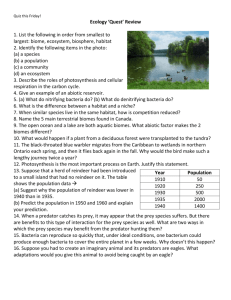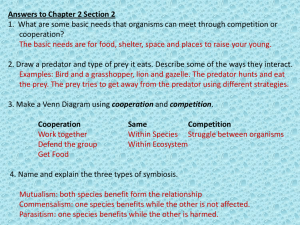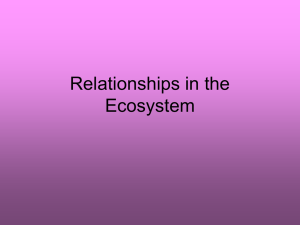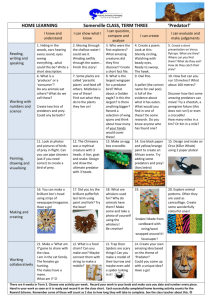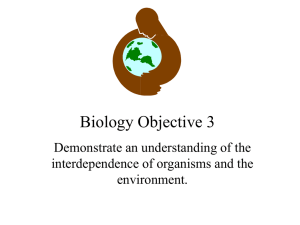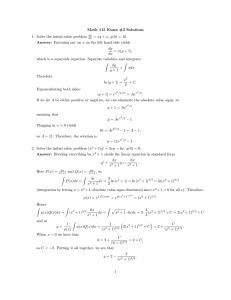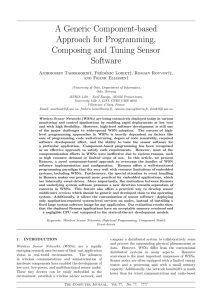Biology Objective 3
advertisement
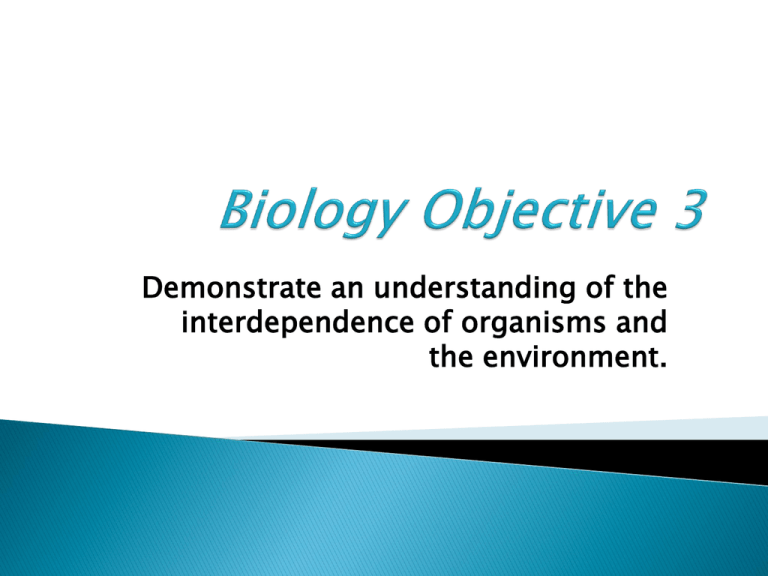
Demonstrate an understanding of the interdependence of organisms and the environment. Biotic – the types of plants and animals that live there. Abiotic – nonliving characteristics such as soil type, rainfall amounts, and average temperature cycles. 1 4 2 5 3 6 Choices: Grasslands, Desert, Temperate Forest, Tundra, Rainforest, Boreal forest Not sure? http://www.ucmp.berkeley.edu/glossary/gloss5/biome/ Biosphere – The entire area of the planet that supports life. Biome – An area defined by specific abiotic and biotic factors. Community – The groups of living things in an area and how they relate. Symbiosis is a close relationship between two living things. When both are helped it is called mutualism When one is helped and there is no effect on the other it is called commensalism When one is helped and the other is harmed it is called parasitism Sharks are cleaned by a little fish known as a Remora. The shark never eats them since they clean bacteria off of the shark. The remora use the shark bacteria as a food source. Since both species are helped, this is mutualism. Orchids live high in tree-tops on the branches of large trees. They do not harm the tree, but they are helped by being raised up into the sunshine and receiving water. Parasites harm or kill the host. A good example is a tape worm. It intercepts all of the hosts food, causing the host to starve to death. 8. Clown fish are small reef fish that seek protection from predators by sheltering themselves among the stinging tentacles of sea anemones. Clown fish are very territorial and can potentially scare off predators of sea anemones. This relationship is an example of -A. neutralism B. mutualism C. parasitism D. commensalism Remember all living things expend (use) energy! F. sunlight G.photosynthesis H. oxygen J. carbon dioxide At one end of the diagram are plants. They are called producers since they are capable of turning sunlight into food by photosynthesis. They pass 10% of the energy they absorb to animals that eat them. 1st Order Consumers eat only plants and are also called herbivores. 2nd Order Consumers eat primary consumers and are called carnivores. 3rd Order Consumers; eat secondary consumers; they are also known as carnivores If a consumer eats both animals and plants, it is called an omnivore. 14. Wolves and hawks are at the same trophic level because they — Trophic level A both live on land Means 1st , 2nd B are both large mammals rd Order or 3 C both eat primary consumers Consumer D have similar hunting patterns Energy Decomposers 43 Approximately how much of the energy available in the tissues of the producer is eventually incorporated into the tissues of a secondary consumer? A Less than 1% B Between 20% and 30% C Approximately 50% D More than 50% Arrows in a food chain show the direction of energy flow. This is not the only feeding relationship for these organisms. When several or all of the food relationships are shown it’s a . . . Food webs attempt to show all the feeding relationships in a community. The direction of the arrows shows the direction of energy flow. At the bottom of every web and every chain is a plant. These are the only things that can turn sunshine into food. 20. Which of these groups of organisms would most likely have accumulated the largest concentration of a longlasting chemical pollutant in their bodies? Need help? http://www.tutorvista.com/content/biology/biologyiv/ecosystem/biological-magnification.php A Phytoplankton B Zooplankton C Lake trout D Gulls Prey are the animals that are eaten as a food source for the . .. Predator. This is the hunter animal. The population of the predator must be less than the prey or they do not have enough food. Population (100s) Time (months) Prey Predator 22 Which of the following is most likely to cause increases in a predator population? F. Fewer prey G. A reduction in competition H. More parasites J. A period of drought Population (100s) Time (months) Prey Predator This is the maximum number of a specific population that an area can support with enough food and living requirements. It is shown by a line on population graphs for a specific species. F. competing with birds G. making its own food H. hiding from predators J. running very rapidly Precipitation (rain and snow) falls on plants and ground. Plants respire and evaporate water back into clouds. The ground filters the water run-off into the lakes where it evaporates again. 26. The diagram shows physical changes that occur in the water cycle. Name each labelled process on your answer sheet. Use scientific terms. Glucose C6H12O6 is produced by plants, eaten by animals. Photosynthesis Animals exhale CO2 which is taken in by plants to make glucose. Cellular Respiration Lightning and bacteria in the ground “fix” nitrogen into a form usable by plants. Nitrogen is absorbed by plants, through their roots as nitrates, so they can be used to build amino acids essential for building proteins, enzymes, and the nitrogen bases of DNA. Ozone O3 is a protective layer at the top of the atmosphere. However, when it occurs near the ground, it is very harmful to all living things, it is SMOG More than 90% of fresh water is locked in ice at the polar caps and in glaciers. Much of the fresh water is polluted by land run-off, dumping of wastes and excess heat directly into lakes, oceans and rivers. Global warming, also called the Greenhouse Effect is caused by excess burning of fossil fuels and destruction of our oxygen producing protista in the oceans, and deforestation on land. Less plants means less oxygen and more CO2. F Recycling cardboard boxes G Washing small loads of laundry H Driving large cars J Building wooden fences There are natural variations in all populations. As climate changes occur, and as pressures in terms of food, space, shelter and predation occur, some variations allow a species to survive. The members who survive then reproduce causing the change to become a characteristic of the species. Geographic isolation can cause two different natural variations to become prominent causing two separate species. Reproductive isolation can have the same effect. A population is extinct when the last of that species is dead. Example: There are no more dinosaurs. What happened? Their habitat was destroyed. When they no longer have what they need to live, they die. These are imprints or remains of living things. In undisturbed layers of sedimentary rock, the deeper it is, the older it is. Give us information about extinct species. Homologous means they have the same origin, but may be different now. Example, the upper arm bones in dogs, cows, cats and monkeys. Analogous means they have the same function but come from different origins. Example, bird wings and wings of bats. Viruses are not alive because they can not reproduce on their own They do not grow and develop They do not exchange with their environment Measles, mumps, colds, influenza, cold sores, mononucleosis, EpsteinBarr virus are all illnesses that are caused by a virus. A virus has a coat, a strand inside of DNA or RNA, and some type of attachment appendage. Bacteria can cause illnesses, too, however 90% of all bacteria is helpful, NOT harmful. Without bacteria, you would not be able to make or eat cheese or ice cream. Without them, you would be ill most of the time. Strep throat and staph infections are examples of bacterial infections.
